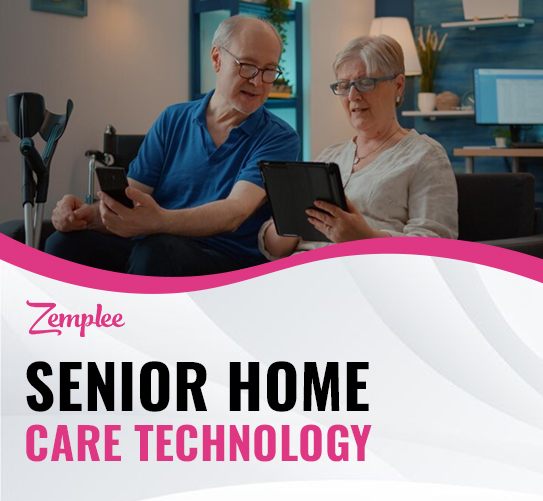The current elder care system has come under scrutiny due to COVID-19, yet new technologies are transforming home-centered senior care in the future.
The baby boomers who have taken up the mantlepiece of senior citizenship are responsible for the major corporations of the 20th century. Society is currently under a very humiliating spotlight at a time when it must go above and beyond to provide the elderly with all the assistance they require.
There are fewer healthcare aides available for each elderly adult. The growing population of those over 60 is the reason for this declining trend. This group is expected to increase at 56% faster than the rest of the world’s population during the next ten years, making matters worse.
Senior home care technology is one method to reduce this harmful divide between the elderly and technology. Given the prevalence of wearables, sensors, and innovative health IT systems, the potential cost for entrepreneurs who pass on the newest advancements in senior technology might be significant. Let’s see how!
Are Older Adults and Technology Compatible?
Yes, that would be a clear-cut response. There is conflicting evidence to support the idea that older people utilize technology very little. It’s not at all. First, Tim Berners Lee, the man who created the World Wide Web, was a baby boomer. Like their younger counterparts, people in the middle and older age groups are becoming friends with technology. According to a new study, nine out of ten American adults use the internet. Older tech-savvy individuals use smartphone apps to book vacations, shop, and attend family gatherings.
In the follow-up section, we’ll examine the causes of the upward trend in older persons’ technology use.
The Technology Supporting the Management of Senior Care
Even if the number of new jobs in the healthcare industry is expected to increase by 15% between 2019 and 2029, the aging population will outnumber this growth rate. By 2050, there will be a 3:1 ratio of caregivers to caretakers for the vulnerable micro-sections of persons aged 80 and older. Senior home care technology might be fresh air for a weary healthcare system. Introducing the technologies that are improving the effectiveness of senior care:
Putting Medical Alerts on Autopilot
Approximately 12 million Americans over 65 live alone, according to Pew Research. Seniors in such a situation would benefit most from technology that provides timely notifications. Wearable technology, homecare voice units, and smartphone applications are examples of how this type of technology for senior citizens is widely known and used.
Unfortunate limb twists falls down stairs, or seasonal fever frequently endanger the health of our elderly. Since AI still advances to the general, more aware level of intelligence, healthcare app developers should focus on creating wearables for the elderly.
Healthcare app development services aim to create a virtual, centralized monitoring system that works with everyday wearables like wristbands and smartwatches. Thanks to recent developments, wearables may now record data, examine patient behavior, and alert virtual caregivers about abnormalities.
Telemedicine With good reason, the worldwide telemedicine industry, which is driven by the leading telemedicine sector trends, is expected to reach a valuation of US$185.66 billion by 2026. Leading applications of telepathology, teledermatology, telepsychiatry, and telecardiology, among others, will propel this adoption in healthcare institutions and among individuals well-suited for home care.
AI and 5G will work together to create a remote monitoring environment, allowing the doctor-patient community to treat treatable illnesses virtually. Even patients might track changes in their health and use the data to arrange virtual consultations with medical professionals thanks to trackers integrated into wearables and monitors.
Artificial Intelligence
There will be more than 21 billion active IoT connections worldwide by 2025. 90 percent of American households have IoT devices connected to their network. This network of networked digital devices can enhance the advantages of senior care technology.
Sensors, for example, can alert part-time homecare providers when an older person gets out of bed at a strange hour. Voice assistants that the elderly population with disabilities can utilize to operate doors, lights, and household appliances might be another use of AI technology for senior care.
Since there will be a boom in initiatives involving elder care technology shortly, healthcare app developers may focus on these areas of senior care innovation.
Medical Software: In 2019, the Electronic Medical Records (EMR) market was valued at US$27.67 billion. By 2027, revenues are expected to be over US $40.50 billion. The software’s increased shareability and ability to transfer data between applications are primarily responsible for the expansion.
Since patients frequently switch doctors, this research might be considered a breakthrough. It would take needless time for medical professionals to make the correct diagnosis if they had to recreate and re-study patients in case of a doctor switch.
With the accuracy and integrity of the data encrypted for later use, EMRs would guarantee a seamless transition for physicians and patients.
How Can Business Owners Benefit?
According to a National Science and Technology Council research, organizations like a health tracking app development business should consider these important factors while developing solutions to support the monitor elderly parents in society.
Maintain an Intuitive App Interface
As was previously said, older adults have difficulty using gadgets. Therefore, rather than making their lives more difficult, senior home healthcare technology should make them simpler. App developers should decide on an intuitive in-app design, and they shouldn’t alter it at random. Automated chatbots that are self-supervised and learn using machine learning algorithms and the preferences of their senior customers may provide the most significant tech help for elders.
Examine a Comprehensive Demographic Analysis
Regarding technology, elders believe that low-cost solutions are the best. These folks generally agree that expensive, ostentatious phones don’t address their issues, which ignore a generational divide in technological knowledge. They would choose to get inexpensive flip phones or qwerty keypad phones with high durability that let them use them for a day or two on a single charge.
Financial Status and Literacy Rate: A Crucial Differentiator
At least some older adults in first-world economies, such as the US and the UK, are familiar with the technology. If you compare it to a third-world location, you’ll see the impact that basic education makes. Additionally, even though cell phones are now more inexpensive due to dramatically decreasing manufacturing costs, the applications are subscription-based.
Simply put, you would use it if you had to and could afford to. From a revenue standpoint, it is usually advantageous to create senior healthcare solutions with the target region in mind, even if this is a socioeconomic issue outside the purview of a healthcare application development business.
Conclusion
Our lives will continue to be increasingly impacted by senior home care technology and in a positive way. Furthermore, elder Americans have conceded to this idea, to be honest. According to World Economic Forum research, 70% of seniors are already online. Some use the internet for comfort, while others do because it is intrusive.
Pure numbers indicate the mathematical requirement of promoting technology solutions for the elderly. The unclaimed slot has to be taken by someone. If you want to find out more, visit us at Zemplee!


